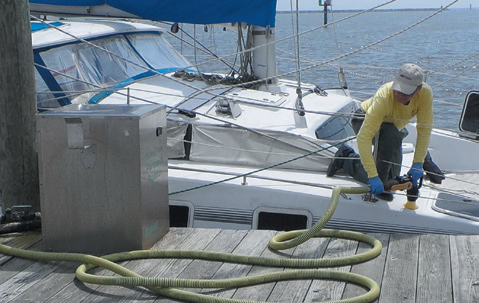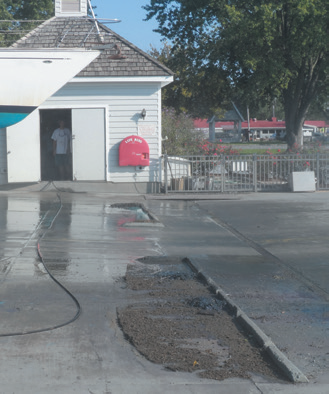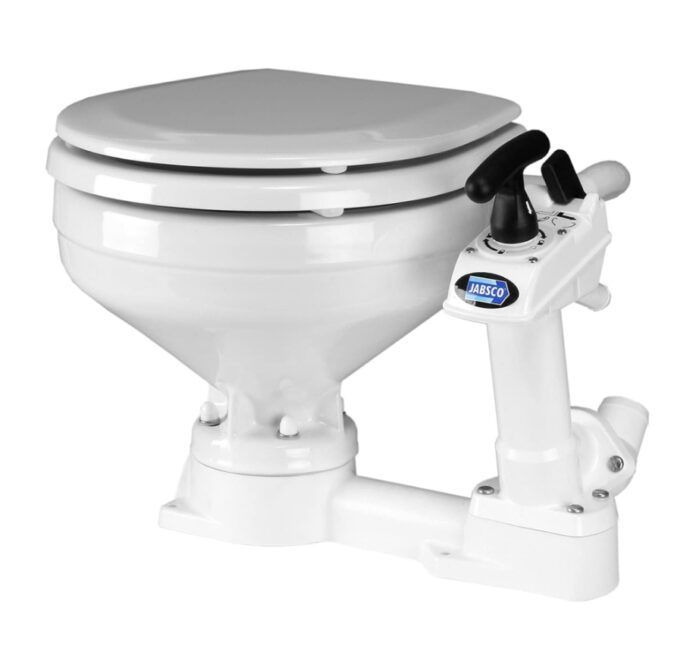Many pumpout facilities are actually dumped in municipal wastewater treatment facilities that can be overwhelmed by the addition of treatment chemicals.
Spring is boat prep season, which is followed closely by the first cruise of the season. As the author of many articles on marine sanitation and my experience designing industrial waste facilities, I’ve become known around the marina as the wastewater guy, so when my neighbors have a question about how to dispose of something or why the head isn’t working right, they come right to me. Fun.
WHAT CAN GO IN THE HEAD?
The traditional rule is that if you didn’t eat it, it doesn’t belong in the holding tank. That’s a good starting point, from which we begin our discussion of safe exceptions, beneficial treatments and why certain things are trouble.
Toilet Paper. Only single-ply toilet paper. Scott makes several good ones; see PS reviews in October 2016 and June 2011. Inform guests that ONLY toilet paper may go in the head, and encourage them to use lots of water when needed. Water is the key, since any amount of paper and waste will break down if there is enough water. Do not keep Kleenex in the head compartment, it is orders of magnitude more durable than TP and will not break down in water. Provide zip lock bags in an obvious place for other disposal items.
Acid Cleaners. Periodic acid treatments can reduce scale build-up caused by flushing with hard water (seawater is very high in calcium). Sew Clean (see PS August 2017) strikes the best balance between effective scale removal and safety. Vinegar is so weak as to be completely ineffective in any practical treatment regimen. Hydrochloric acid (muriatic acid) is hazardous to work with and damaging to aluminum. A proper annual cleaning should be sufficient.
Toilet Bowl Cleaners. Some will harm the tank culture and make things smelly, some will strip the lube from the pump, and some are safe, in moderation (see Inside Practical Sailor, “A Simple Solution for Toilet Bowl Stink”).
WHAT CAN’T GO IN THE HEAD?
Oils. The only substances—other than non-degradable paper and forbidden solids—that correlated to sludge build up in PS testing are vegetable oil and cooking grease. It causes solids to cling to the walls and buildup on the bottom, creating deposits that the gentle agitation of sailing won’t break loose. It is barely degradable and slows the beneficial digestion processes by sealing the bacteria in little raincoats—the oil coats the bacteria, blocking the absorption of water soluble foods and enzymes. Metabolism slows down, degradation halts, and the sludge clumps together. This is why disposing of cooking oil by restaurants is illegal—it gums up the pipes and interferes with sewage treatment. Instead of flushing oil to lube the head, maintain it properly each spring with synthetic grease, following manufacture instructions.
If there are solids on the tank walls that are preventing you from seeing the liquid level, a cup of an effective degreaser (Simple Green or Oil Eater) followed by a brisk sail is the best treatment. Some suggest adding 10 pounds of ice for some extra scrubbing effect, although it didn’t help in our testing—cold doesn’t help degreasers work. Don’t add it through the head! It will strip the lubrication. Pour it in the pump out and rinse it down.
WATER QUALITY STANDARDS
One ounce of paint (25% Cu) = 75,000,000 gallons of water. If pollutant levels exceed these levels, aquatic life will suffer. For copper, this is about 1/4 of a penny in an olympic swimming pool. Not much in a harbor full of boats. And remember, the boat is not the only source. This includes all sources, many of which we are responsible for indirectly.| CONTAMINATE | ACUTE | CHRONIC | OUNCES PER 660,000 GALLONS (OLYMPIC SWIMMING POOL) |
|---|---|---|---|
| ARSENIC | 69 parts per billion (PPB) | 36 PPB | 0.19PPB |
| COPPER | 4.8 PPB | 3.1PPB | 0.02 PPB |
| ZINC | 90 PPB | 81 PPB | 0.42 PPB |
| OIL AND GREASE | 100-1000PPB | 1-10 PPB | 0.005 - 0.05 PPB |
Bleach, Drain Cleaners, Etc. Bleach is rough on the rubber components of the system, disrupts the natural balance of bacteria in the holding tank, and will never be enough to actually sterilize the tank, since bleach has poor penetration effectiveness. It ends up making the odors worse and decreasing the life expectancy of the hoses and soft parts of the head. Not recommended under any circumstances. If you want to clean the system prior to working on it, flush with lots of clean water, followed by a brief soak in vinegar and one last flush with clean water.
Antiseptic Holding Tank Chemicals. Our reviews of head treatment chemicals (see PS February 2012, December 2012) explained that bio-augmenting treatments are most effective. Only portable heads benefit from antiseptic products (PS September 2018), but there is still a catch. The chemicals are quite toxic to bacteria and should never be disposed of in a septic tank, where they will upset proper operation. Only a large public treatment works. I’ve seen smaller treatment works crippled in my consulting work, and many prohibit disposal by chemical toilet service companies.

facilities that can be overwhelmed by the addition of treatment chemicals.
What about wastes we might generate while cruising, away from shore-side disposal options? Perhaps the head isn’t the best place, but it may be the only choice. Because the answer is going to be “no” for many of these, keep a few empty PET (water bottles) and PE (oil and laundry detergent) bottles around for what must be kept.
Oily Bilge Water. Also soapy water from degreasing parts. Store it for on-shore disposal if possible. If not possible, use as little soap as possible (biodegradable) and let it sit overnight, so that the oil can float to the top (save the oil for on-shore disposal) before pouring into holding tank. With only well-emulsified oil remaining, the bacteria should be able to degrade the soap and oil over the next week, until it can be discharged, either well offshore or at a pump-out facility.
Cooking Oil. Keep this in bottles until you return to shore. Even if it were not for the environment, there is damage to the holding tank and clogging of sink lines to consider. Also used oil, of course.
BOATYARD DISPOSAL
What about boatyard wastes? Many products are becoming water-based, but that does NOT mean we can pour them willy-nilly on the ground or in the sewer. In many cases, they are hardly less toxic at all, no matter what the label says.
Recycle. Read the instruction on the recycle collection tank. Recycling processes vary (I worked in the industry for 30 years), so acceptable materials vary, and how they must be separated vary. Oil and fuels can generally go in the used oil tank. Only ethylene glycol and propylene glycol antifreeze go in the antifreeze tank—never alcohol-based winterizing antifreeze, fuel-water mixtures, gasoline-water mixtures, or soapy water.
Since most “virgin” products for sale today contain some recycled component (no matter what they say), we need to work together to avoid recycling materials that will degrade the products made from it. Recycle bins are not waste tanks, they are feedstock tanks. Hopefully there are also oily water and hazardous waste containers with clear instructions. Mixing gasoline with used antifreeze or paint/solvents with used oil will render the entire container hazardous waste, preventing recycling and incurring considerable expense to the marina.
Water-Based Paint. These products tout “easy clean-up” as a benefit, but this claim is misleading at best and dangerously false in many cases. Antifouling paints contain the same copper and zinc as solvent-based paints, and sewer ordinances ban disposal for reasons of toxicity. Brushes cannot be washed out in the sink or on the ground. Rollers and trays must be left to dry and disposed of as solid waste. At best, “easy clean-up” means you can try to wash your arms with soap and water, but given how fast water-based paints dry, this is probably more difficult than with oil-based paint. Better to wear long sleeves.
To quote Interlux AquaOne Product Specification Sheet: “Remainders of AquaOne cannot be disposed of through the municipal waste route or dumped without permit. Disposal of remainders must be arranged for in consultation with the authorities.”
Antifouling Powerwash Water. The wastewater from cleaning hulls is far too contaminated for direct discharge. Scrubbing the hull in the water is a more delicate matter, with best practice guidelines that specify that the gentlest means possible should be used and that no paint-plume should be visible (See “Cleaning Your Hull,” Practical Sailor April 2018). While this may not be state law, it is typically a condition of the marina’s operating permit, giving it the effect of a local regulation.

for runoff into adjacent waters, most boatyards are
required to trap powerwash runoff to be sent out later
for treatment.
Phosphates. Identified as nutrients that contribute to algae blooms and eutrophication, these were voluntarily removed from US laundry detergents in the early 1990s, and 17 states have either partial or complete bans on use in dishwashing detergents. However, we still occasionally suggest a cleaner containing phosphate or TSP for specific cleaning tasks. It is particularly effective before painting, and unlike organic cleaners, it is fully compatible with bleach. Use only the bare minimum, and when possible, guide the run-off and excess onto grassed areas; the plants will take it up as fertilizer, preventing it from reaching surface waters.
IT BEGINS AT HOME
Conserve water at home. This isn’t just a desert thing. Every drop of water that reaches the sewer adds volume and reduces treatment efficiency. The treatment plant is more effective at lower flow rates.
Reduce Storm Water. Some older cities have districts where sanitary and stormwater sewers are combined. In dry weather or light rains, lift stations transport the waste to the treatment plant. However, when it rains hard, pumping and treatment capacity is overwhelmed and the excess volume, including raw sewage, is discharged to surface waters. These are the sewage overflows that we commonly hear about—they are not accidents, just a consequence of obsolete design.
If you live in an area served by combined sewer outfalls, every drop of rainwater that can be absorbed into the ground rather than discharged to the sewer is a gallon of raw sewage that will not overflow during the next rainstorm. If you can direct your roof and driveway runoff into the grass, it helps. This issue is most serious in freshwater areas, because unlike seawater, there is no salt to deactivate infectious organisms.
This may sound like a lot of work, but if we like to swim, fish, and sail, this is what it takes. I never thought of myself as a particularly “green” individual. I’m a chemical engineer, for heaven’s sake. But this is what the math says.
Related post: “What Happens to Your Pumpout Waste?“






































Fantastic article; thank you. While reading all I could think of was how inadequately equipped marinas and yacht clubs are dealing with this waste and runoff, coupled with the gap in boater education on the issues and impacts of our actions.
I have two things on my boat that make head and cooking fats no problem at all:
1) I have a composting toilet – use as much toilet paper as you want. It reduces the moisture and air-rates the solids to keep the bacteria happy. There are no valves and seals, no chance to flood the boat.
2) I have a dog, she loves the excess cooking fat and does the “pre-wash” of the dishes so there is very little food scraps.
Drew – great article! Would love to hear your thoughts about the bareboat operators. All of them that I am aware of prohibit ALL TP in the heads. This is the thing that my guests complain about the most when sailing. You suggest that single ply is ok.
Great. Imformative article. Should be part of every boaters’Bible’
Also very useful for anyone using a septic system on land.
You need to use the best boat wash to get rid of dirt, stains, and spots on your boat. Hence, products like dishwashing liquid or detergent are no good. They are not strong enough as alternatives for boat wash and they are not safe because they can strip wax and marine materials off your boat surfaces. Plus, they aren’t friendly for human and marine life. 🙂